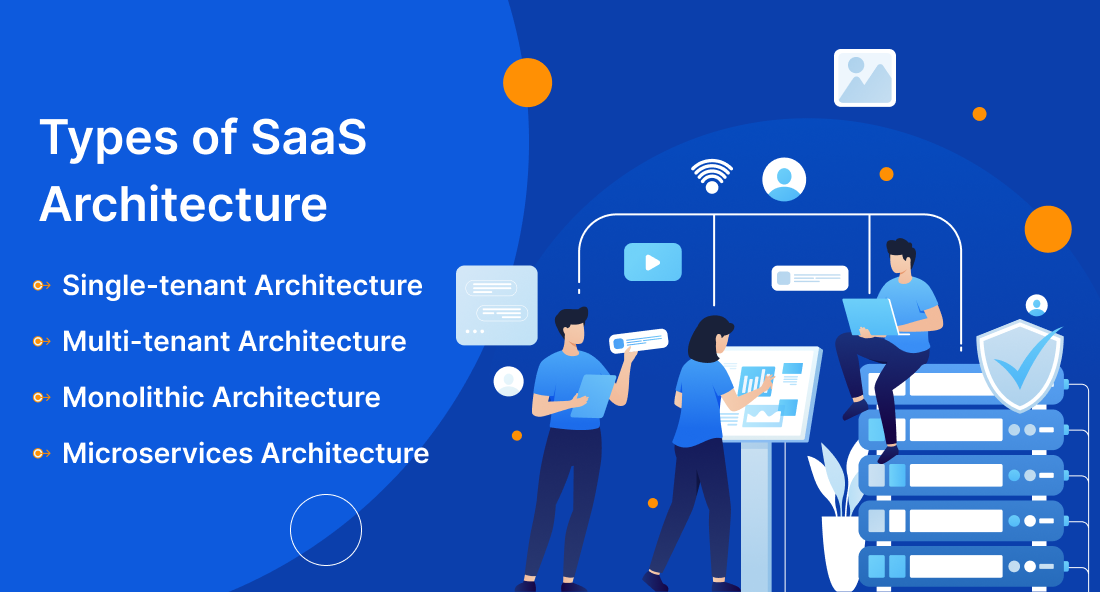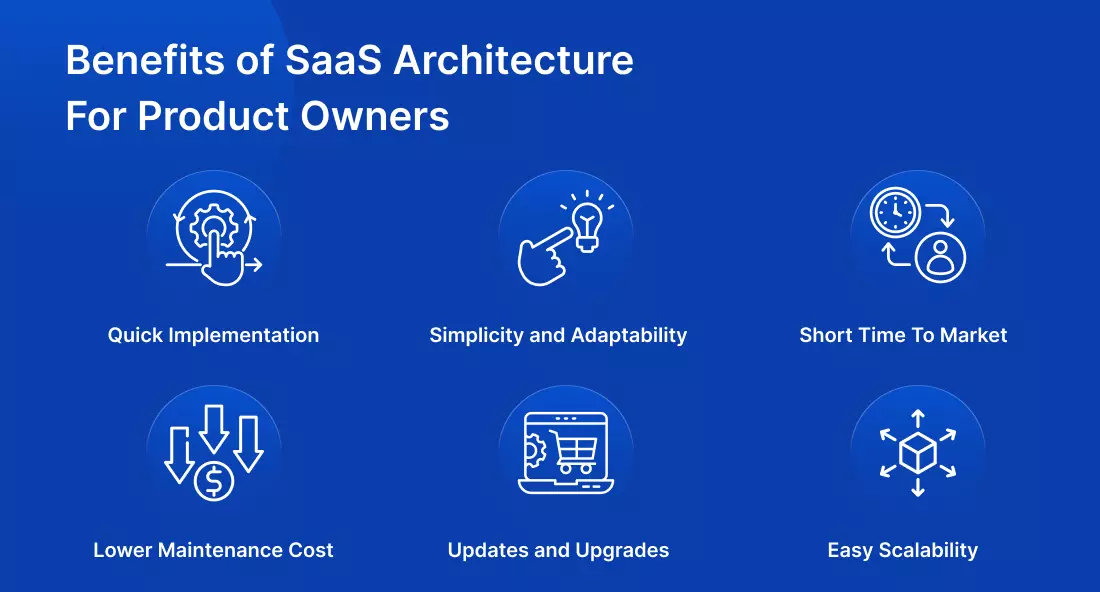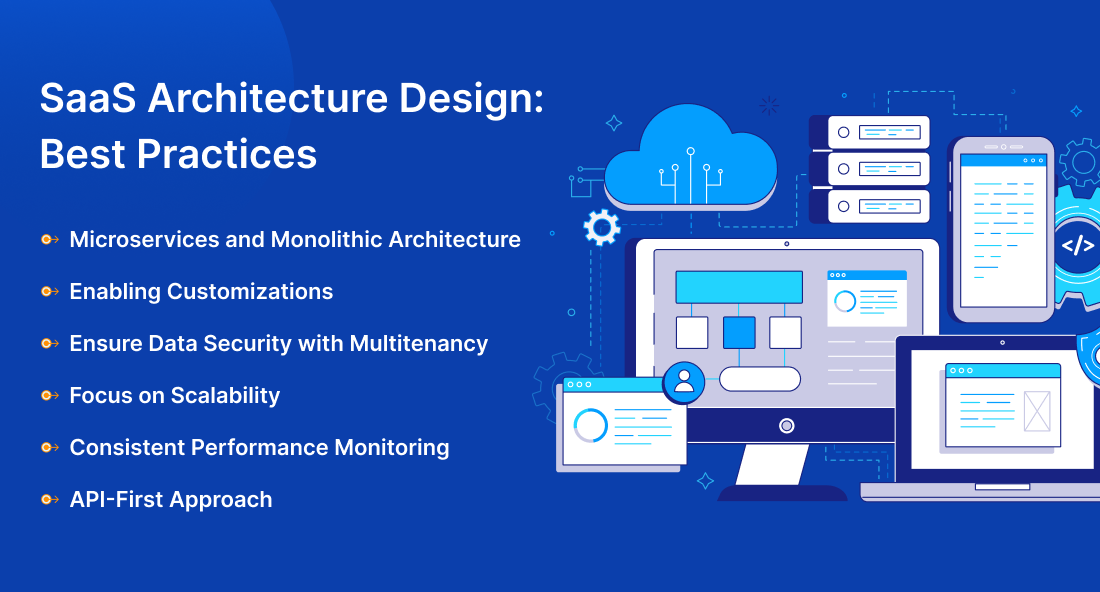SaaS Architecture: Features, Tenancy Models, & Best Practices To Know
Last Updated on December 10, 2024
Quick Summary
Quick Summary:
SaaS, or Software as a Service, has become increasingly popular among companies to streamline business processes and operations. But when it comes to developing a powerful, innovative, and scalable SaaS platform, decision-makers must understand that their goal isn’t achievable without a strong architectural foundation. Yes, we are talking about SaaS architecture, one of the main aspects to comprehend while building a SaaS product. Continue reading to learn about different types of SaaS architecture and its benefits, challenges, and best practices.
Before indulging into different aspects, it will be crucial to understand what SaaS Architecture is. SaaS architecture is the answer for companies that seek scalability, flexibility, and accessibility in their applications. In simple terms, it is an architecture model of Software as a Service that allows users to utilize the features of an application hosted on a remote server over the internet.
It’s because of a comprehensive SaaS architecture model multiple companies or organizations can access a single application platform, including the hardware, operating system, network, and many other elements. Software as a Service is a way to deliver software applications online. Most of the time, users need to pay a small subscription fee to gain access and enjoy almost all the features and perks of the application. SaaS is a part of the cloud computing landscape, similar to PaaS (Platform as a Service) and IaaS (Infrastructure as a Service).
But how does SaaS differ from PaaS and IaaS? Let’s look into it.
➙ SaaS (Software as a Service): In SaaS, all the app data is hosted on the remote server, and users can easily access it using a browser on the internet.
➙ PaaS (Platform as a Service): In PaaS, an organization is given access to a cloud environment where it can develop, manage, and share the applications.
➙ IaaS (Infrastructure as a Service): In IaaS, a cloud computing service gives access to cloud servers, storage, and networking organizations to organizations.
Now that you know the basics of Software as a Service (SaaS) architecture, it is time to understand its different types. Having proper knowledge of these SaaS architecture types or tenancy models will help you to determine the right architecture type that meets your customer demands, provides flexible development solutions, and offers smooth operations. Business owners can choose the most beneficial SaaS architecture type considering factors, such as scalability, migration complexity, customizability, expenses, and security. Let’s review them one by one.

Single-tenant SaaS architecture involves dedicating a single instance of the application, its infrastructure, and its database to a single customer paying for that specific software service or component. This type of architecture offers the customer a great advantage, as they will not have to share their database or information with other users or customers. Also, single-tenant architecture will allow the buyers to scale up or down the software instances as per their business requirements.
In multi-tenant SaaS architecture, every single instance of software holds the capability to serve multiple customers at the same time. Multi-tenancy or one-to-many SaaS architectures involve numerous organizations sharing the same database and application information. Most businesses, especially startups, choose multi tenant architecture in SaaS due to its lower cost, reliable security systems, and higher performance. It will not be possible for customers to access other customers’ data and app information even though everything is stored in the same database.
The monolithic architecture is built as an indivisible module or unit that cannot be split. It is built around a server-side and client-side interface, where the users can manage and maintain all the functions from a unified location. The server-side part, database, user interface, and several other components are included in a single large database without any other added modules. Hence, any kind of changes or updates made to the functions or programs will be reflected in the entire stack.
In microservices architecture, all functions are segmented into independent modules, which the users can deploy separately as per their needs. Microservices architecture involves small services that run in individually separate processes and interact with APIs. Different services can be developed using different technologies or programming languages. It will be possible to enhance, scale, update, or upgrade separately in microservices architecture, offering excellent flexibility to the customer.
Take A Step Towards Transforming Your Business With SaaS!
Discover how SaaS architecture can revolutionize your organization’s software delivery model. Elevate your SaaS development game by partnering with an expert SaaS Development Company.
SaaS architecture offers significant opportunities and benefits to businesses of all sizes to offer flexibility and interactive cloud-based software services to their customers. If you are a product owner, it will be crucial to scroll through the benefits of choosing the Software as a Service architecture to create a compelling and feature-rich SaaS application.

SaaS-architecture-based solutions are a lot easier and quicker to implement because they are hosted on a cloud server that is managed and maintained by the cloud service provider. Rapid implementation of SaaS Platform architecture will shorten the development time and add to the speed and performance of the SaaS application.
SaaS architecture offers excellent simplicity and adaptability when it comes to developing a Software as a Service platform. It will be easy for programmers to understand the simple architecture, leading to rapid and efficient development. Also, SaaS-based applications are adaptable to changes, updates, or fixes for a specific part or the entire database.
Utilizing the potential of SaaS application architecture, it will be feasible for product owners to deploy the software to the end-user quickly. As the infrastructure, networks, and other core components are taken care of by the service provider, businesses can focus on offering customizations and advanced features to valued customers. This shortens the time to market and allows organizations to stay ahead of the competition.
One of the most significant benefits of the SaaS architecture model is that businesses would not necessarily need upfront hardware, infrastructure, database servers, and other components, let aside maintain it. Also, businesses will only have to pay subscription-based fees to the cloud service provider according to their usage or requirements. It will be a lot easier to calculate or predict the monthly or annual expenditures, leading you to invest the fortune wisely.
Using the solutions based on the SaaS application architecture, updating or upgrading the cloud platform or application will be easy and simple. You can easily manage everything from one place as all the app information and data are unified. Offering or serving your users with new releases, updates, and packages can be hassle-free.
Scalability is the major benefit of Software as a Service architecture, offering businesses the flexibility to seamlessly scale up or down as per their requirements. Business owners can easily expand their SaaS platform by adding more features and functionalities without worrying about hardware and infrastructure expense. Due to easy scalability, you can scale horizontally or vertically depending on the ever-changing business demands.
Nothing good comes easy without any challenges or hurdles; The same is applicable to SaaS architecture, as it also has a few challenges you need to overcome. However, with the proper knowledge about these obstacles of SaaS application architecture, you can find a way to win them over. Here are the SaaS architecture challenges you may face during the development of your SaaS applications.
When selecting SaaS architecture, one of its concerning aspects is that you will lose control of data and information to some extent. All your crucial data and information will be stored on the remote cloud servers at the service provider’s end. You can access, manage, and maintain the data but wouldn’t have direct access to the infrastructure or servers that store the data. Also, data portability and switching to a new cloud service provider will be difficult.
How to overcome: Select the right cloud service provider that will maintain the confidentiality, integrity, and security of your sensitive data and information and provide you substantial control over the database.
Data security is considered to be another significant challenge of SaaS system architecture. Product owners should know that SaaS involves entrusting the data and information to cloud service providers that are responsible for security and protection against data breaches and unauthorized access. So, it involves some security risks in choosing the architecture of SaaS for developing large-scale platforms.
How to overcome: As it is the vendor’s responsibility to provide essential security for the data and information, you should ensure that proper safety measures and certifications are in place. Also, implementing the multi-tenancy best practice for the SaaS model architecture will enhance data security.
Some cloud service providers or vendors make it difficult for businesses to switch or migrate their databases to another service provider. Although service providers will not directly stop you from migrating, they will do so by imposing technical and financial restrictions.
How to overcome: You can overcome the Vendor Lock-In challenge by using multiple cloud services and distributing the database or workload. Thus, you can have the benefit of smoothly switching between the vendors. Selecting a cloud service provider that best suits your long-term requirements will also help you win over this challenge.
Limited customization can be a challenge for businesses that have highly specialized requirements. With SaaS platform architecture, you can get fewer customization options, as most SaaS tools have pre-built functionalities.
How to overcome: Focusing on customization while developing a SaaS application or platform is a way to overcome this challenge. Businesses need to consider all kinds of futuristic possibilities of advancements or modifications to the application and enable customizations accordingly during the development.
Depending on the type of industry and services you offer, you will need to follow different regulatory compliance requirements. Implementing GDPR or HIPAA requirements should be crucial to developing a successful SaaS product.
How to overcome: You can resolve this problem by choosing a SaaS provider that complies with the essential laws and regulations.
It is certain that experimenting with different strategies and tactics will only lead to building a successful SaaS architecture design. Most businesses want to develop a SaaS product that meets their specific needs and requirements, which cannot be achieved without a perfectly designed SaaS application architecture. Some businesses have also leveraged the power of OpenAI for SaaS to develop an efficient and productive SaaS application architecture. However, when discussing the Software as a Service architecture design aspect, these best practices will help improve the end product and smoothen the development process.

A monolithic SaaS architecture approach can allow developers to build, patch, or change any functionality from a single place without changing the entire application. While Microservices-based SaaS application architecture is a better choice when you need to write, test, or deploy services independently and create a full production environment. For example, Netflix utilizes different microservices to execute different functions like user analysis, movie recommendations, adding copyright markings, and billing customers.
Businesses should develop SaaS solutions while focusing on customizations and personalizations. Your SaaS products should be feasible enough for users to easily customize the SaaS solution as per their preferences. Choosing between single and multi tenant SaaS architecture, businesses can offer the required flexibility to customize the components and reduce costs.
Especially for the customization feature, you can obtain better results if a SaaS solution can be implemented with AI in an architecture solution. This will give better results for customer satisfaction.
As mentioned previously, data security is among the major concerns of SaaS architecture. Hence, it will be quintessential to keep the application data and resources secure, which can be possible by adopting a multi tenancy model. Designing the architecture with multi-tenant SaaS architecture can help businesses create a secure and isolated environment for individual tenants, ensuring protection against data breaches and unauthorized access.
With the rising demand for SaaS software solutions in the advancing digital landscape, consistent innovations and upgrades are necessary for businesses to stay in the competition. Hence, focusing on scalability while designing SaaS application architecture will be crucial. SaaS products should offer seamless scalability and flexibility to smoothly integrate with business software and meet the evolving enterprise software trends, market dynamics, and customer requirements.
As soon as you create an efficient SaaS application and ensure the architecture is working smoothly, it is time to monitor the performance of the SaaS architecture. Tracking the performance metrics can help you analyze how well the architecture functions and whether your customers can easily access and use the SaaS application or solution. This best practice will help you improve the overall product and user experience.
Designing the SaaS platform architecture with the API-first approach, you can enable third-party software integrations and upgrade the application functionality. Utilizing APIs with SaaS solutions, you can offer users extended flexibility and customization, making the application more appealing. Evolving or upgrading the application will be easy and hassle-free with the API compatibility of SaaS architecture.
Looking at the companies that have successfully utilized the architecture of SaaS and trying to comprehend their SaaS application architecture patterns can motivate you while planning to develop a new product. Here, we have listed some examples of renowned SaaS Platform architecture or companies that benefited from implementing SaaS architecture.
Google Workspace or G-Suite is the best example of multi-tenant SaaS architecture. Multiple tenants can effortlessly access a single software, sharing a common database over the internet. All the data and personal information of the users and clients are highly secured even though the resources and cloud storage are shared.
Salesforce is a SaaS platform that is built on a multi-tenant SaaS architecture, allowing numerous customers to share resources and data. Utilizing the multi-tenancy model and considering scalability while developing a SaaS architecture, Salesforce has been continuously evolving and upgrading to serve over 150,000 satisfied customers.
Dropbox is a cloud storage and file-sharing service that allows users to store, synchronize, share, and manage data across multiple devices. Utilizing the SaaS architecture, Dropbox allows users to pay only for the features or services they choose while knowing that their sensitive data is secure.
Netflix, a popular streaming service, is the best SaaS example that implemented microservices architecture to manage and maintain both heavy and lightweight workloads on a common infrastructure. It also uses different microservices for billing, user recommendations, performance analysis, video transcoding, and other purposes.
Leveraging the multiple integration capabilities of SaaS architecture, Slack allows users to integrate numerous platforms like Google Workspace and Zoom. This helped the popular messaging platform to provide users with the excellent flexibility to switch between different platforms to execute different tasks.
Now that you’ve reached the end of the blog post, you will have a better understanding of SaaS architecture. Consider the mentioned benefits, challenges, and best practices while developing your SaaS application and take a step towards achieving the business goals while meeting the individual needs and requirements of the users.
If you want to build a fast, scalable, secure, and flexible SaaS application that offers high performance and interactive experience, connect with our SaaS development company without waiting any further.
APIs can help the SaaS application platform interact seamlessly with other external SaaS providers, promoting the application’s flexibility and efficiency. Some of the most common APIs businesses use are Shopify API, BigCommerce API, Salesforce Commerce Cloud API, and Lightspeed API.
Software as a Service (SaaS) architecture is a cloud service models that deploys software on the cloud and allows users to access its features and capabilities over the internet by paying for a monthly or yearly subscription plan. Some of the most renowned businesses that have implemented the SaaS application architecture are Dropbox, Google Workspace, Salesforce, Hubspot, Bigcommerce, and Slack.
With the growing popularity of SaaS in the digital landscape, many businesses have been switching or migrating to SaaS solutions. The reasons behind choosing the SaaS model over the traditional business model include impressive flexibility to scale up, high adaptability, simple-to-understand architecture, and secured user data and information.
Your Success Is Guaranteed !
We accelerate the release of digital product and guaranteed their success
We Use Slack, Jira & GitHub for Accurate Deployment and Effective Communication.